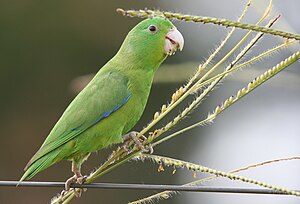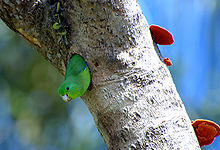Cobalt-rumped parrotlet
| Blue-winged parrotlet | |
|---|---|

| |
| Male in Goias, Brazil | |
| Scientific classification | |
| Kingdom: | |
| Phylum: | |
| Class: | |
| Order: | |
| Superfamily: | |
| Family: | |
| Subfamily: | |
| Genus: | |
| Species: | F. xanthopterygius
|
| Binomial name | |
| Forpus xanthopterygius (Spix, 1824)
| |
| Synonyms | |
|
Forpus crassirostris (Taczanowski, 1883) | |
The blue-winged parrotlet (Forpus xanthopterygius) is a small parrot found in much of South America. It includes the turquoise-rumped parrotlet (Forpus xanthopterygius spengeli), which sometimes is treated as a separate species. The blue-winged parrotlet is mainly found in lowlands, but locally up to 1200m in south-eastern Brazil. It occurs in woodland, scrub, savanna, and pastures. Flocks are usually around 20 birds but can grow to over 50 around fruiting trees or seeding grasses. It is generally common and widespread, though more localized in the Amazon Basin.
Description

The blue-winged parrotlet is a short (12 cm) stocky mainly green bird with a short tapered tail. Sexually dimorphic, the males have blue on the primary and underwing coverts, the remiges and the rump (blue in wings greatly reduced in F. x. spengeli). The face, ear coverts, thighs and vent area are a brighter emerald green. Females, which lack the identifying blue coloration, are easily confused with the green-rumped parrotlet, but there is little overlap in their distributions. The subspecies varies primarily in the overall darkness and the amount of yellow to the plumage.
Taxonomy
For a while it was considered conspecific with the green-rumped parrotlet (F. passerinus), but today all authorities recognized the two as separate species. It is also possible that the subspecies spengeli is better classified as a subspecies of the Mexican parrotlet (F. cyanopygis), or, more likely, a species of its own, the turquoise-rumped parrotlet (F. spengeli).
Name
This is a rare case in which the common name has been more stable than the binomial. F. xanthopterygius initially referred to two species, one of which was a different species, the canary-winged parakeet. Consequently, the Brazilian ornithologist Pinto discarded the name F. xanthopterygius for the blue-winged parrotlet in 1945, and instead applied the next oldest name, F. crassirostris. That same year it was mistakenly written up as F. xanthopterygius crassirostris and it reverted to F. xanthopterygius again. In 1978, Pinto mentioned the mistake in Novo catálogo das aves do Brasil and the name was changed to F. crassirostris. However, as was pointed out in 1999, the original name F. xanthopterygius remains valid per ICZN rules, and consequently this name has been re-applied to the blue-winged parrotlet. To increase the confusion, the name of the nominate subspecies also changed: F. x. xanthopterygius is the subspecies formerly listed as F. c. vividus. These birds were among the first brought back to Portugal in the 16th century by voyagers to Brazil. They were called "toim" (plural, tois) by the Tupi Indians.
Subspecies
There are six subspecies (mentioned differences are for adult males):
- F. x. xanthopterygius (formerly F. c. vividus): N. Argentina, Paraguay, E. Brazil from Bahia south. Secondaries and coverts darker blue than other races.
- F. x. flavissimus: E. Brazil from Bahia north. Front of face yellow.
- F. x. olallae: Near Codajas and Itacoatiara on the north bank of the Amazon River in the Amazon in Brazil. Lighter blue, primary coverts shading towards violet. Smaller. Possibly better considered a junior synonym of F. x. crassirostris.
- F. x. crassirostris: NE Peru, E Ecuador, SE Colombia, NW Brazil. Like olalle, but underwing coverts darker, other blue lighter.
- F. x. flavescens: Central-eastern Peru to E Bolivia. Head and underparts a yellower green than nominate (though face not as yellow as flavissimus). Rump paler blue, undertail more bluish.
- F. x. spengeli: N. Colombia. Blues paler than nominate, turquoise with some violet mixed into underwings. Remiges mainly green; only base is blue.
References
- Juniper & Parr (1998) Parrots: A Guide to Parrots of the World; ISBN 0-300-07453-0.
- Forshaw (2006) Parrots of the World: An Identification Guide; ISBN 0-691-09251-6.
External links
- World Parrot Trust Parrot Encyclopedia - Species Profile
- Birdphotos.com Map of Range

